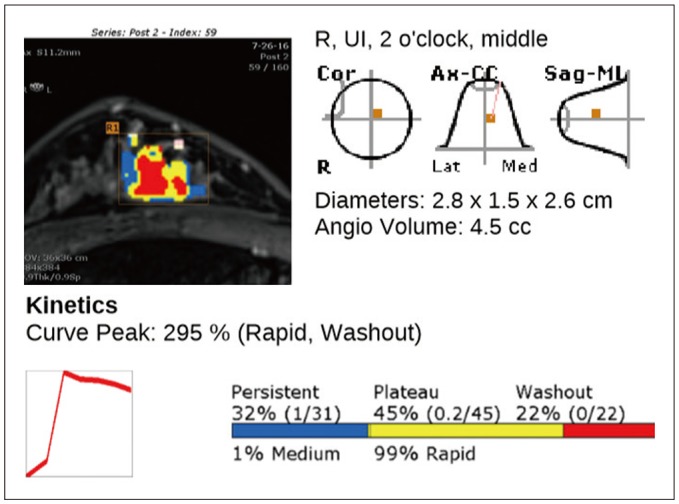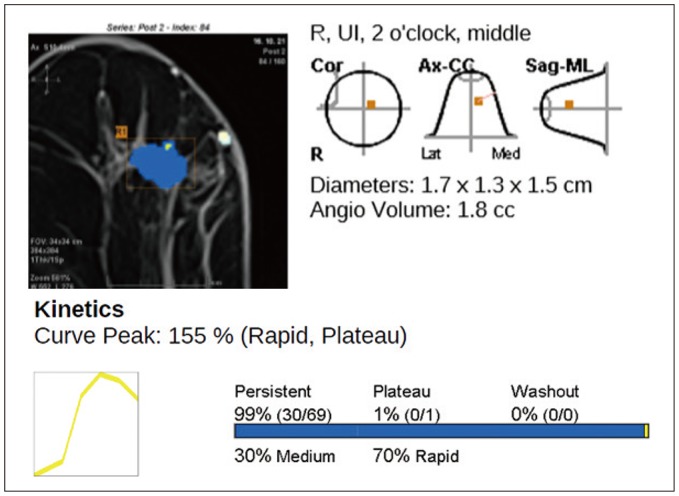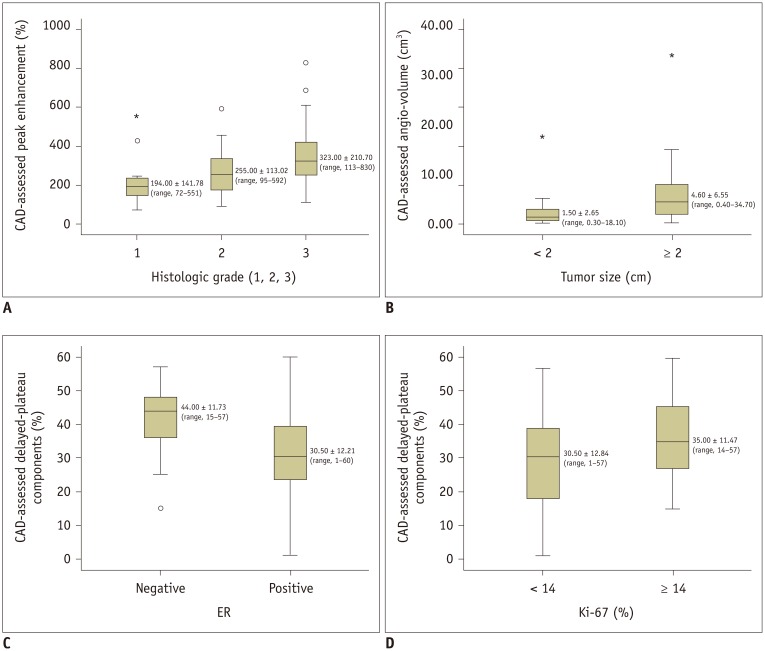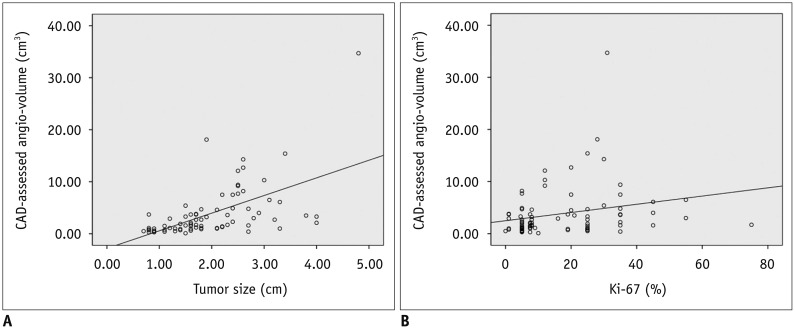Korean J Radiol.
2019 Mar;20(3):411-421. 10.3348/kjr.2018.0587.
Kinetic Features of Invasive Breast Cancers on Computer-Aided Diagnosis Using 3T MRI Data: Correlation with Clinical and Pathologic Prognostic Factors
- Affiliations
-
- 1Department of Radiology, Korea University Anam Hospital, Korea University College of Medicine, Seoul, Korea. krcho@korea.ac.kr
- 2Department of Radiology, Korea University Ansan Hospital, Korea University College of Medicine, Ansan, Korea.
- 3Department of Radiology, Korea University Guro Hospital, Korea University College of Medicine, Seoul, Korea.
- 4Department of Surgery, Korea University Anam Hospital, Korea University College of Medicine, Seoul, Korea.
- KMID: 2438271
- DOI: http://doi.org/10.3348/kjr.2018.0587
Abstract
OBJECTIVE
To investigate the correlation of kinetic features of breast cancers on computer-aided diagnosis (CAD) of preoperative 3T magnetic resonance imaging (MRI) data and clinical-pathologic factors in breast cancer patients.
MATERIALS AND METHODS
Between July 2016 and March 2017, 85 patients (mean age, 54 years; age range, 35-81 years) with invasive breast cancers (mean, 1.8 cm; range, 0.8-4.8 cm) who had undergone MRI and surgery were retrospectively enrolled. All magnetic resonance images were processed using CAD, and kinetic features of tumors were acquired. The relationships between kinetic features and clinical-pathologic factors were assessed using Spearman correlation test and binary logistic regression analysis.
RESULTS
Peak enhancement and angio-volume were significantly correlated with histologic grade, Ki-67 index, and tumor size: r = 0.355 (p = 0.001), r = 0.330 (p = 0.002), and r = 0.231 (p = 0.033) for peak enhancement, r = 0.410 (p = 0.005), r = 0.341 (p < 0.001), and r = 0.505 (p < 0.001) for angio-volume. Delayed-plateau component was correlated with Ki-67 (r = 0.255 [p = 0.019]). In regression analysis, higher peak enhancement was associated with higher histologic grade (odds ratio [OR] = 1.004; 95% confidence interval [CI]: 1.001-1.008; p = 0.024), and higher delayed-plateau component and angio-volume were associated with higher Ki-67 (OR = 1.051; 95% CI: 1.011-1.094; p = 0.013 for delayed-plateau component, OR = 1.178; 95% CI: 1.023-1.356; p = 0.023 for angio-volume).
CONCLUSION
Of the CAD-assessed kinetic features, higher peak enhancement may correlate with higher histologic grade, and higher delayed-plateau component and angio-volume correlate with higher Ki-67 index. These results support the clinical application of kinetic features in prognosis assessment.
MeSH Terms
Figure
Reference
-
1. Folkman J. Tumor angiogenesis: therapeutic implications. N Engl J Med. 1971; 285:1182–1186. PMID: 4938153.
Article2. Schneider BP, Miller KD. Angiogenesis of breast cancer. J Clin Oncol. 2005; 23:1782–1790. PMID: 15755986.
Article3. Hylton N. Dynamic contrast-enhanced magnetic resonance imaging as an imaging biomarker. J Clin Oncol. 2006; 24:3293–3298. PMID: 16829653.
Article4. Dorrius MD, Jansen-van der Weide MC, van Ooijen PM, Pijnappel RM, Oudkerk M. Computer-aided detection in breast MRI: a systematic review and meta-analysis. Eur Radiol. 2011; 21:1600–1608. PMID: 21404134.
Article5. Wood C. Computer aided detection (CAD) for breast MRI. Technol Cancer Res Treat. 2005; 4:49–53. PMID: 15649087.
Article6. Hylton NM. Vascularity assessment of breast lesions with gadolinium-enhanced MR imaging. Magn Reson Imaging Clin N Am. 1999; 7:411–420. PMID: 10382170.
Article7. Kim JJ, Kim JY, Kang HJ, Shin JK, Kang T, Lee SW, et al. Computer-aided diagnosis-generated kinetic features of breast cancer at preoperative MR imaging: association with disease-free survival of patients with primary operable invasive breast cancer. Radiology. 2017; 284:45–54. PMID: 28253106.
Article8. Dietzel M, Zoubi R, Vag T, Gajda M, Runnebaum IB, Kaiser WA, et al. Association between survival in patients with primary invasive breast cancer and computer aided MRI. J Magn Reson Imaging. 2013; 37:146–155. PMID: 23011784.
Article9. Kim H, Kim HH, Park JS, Shin HJ, Cha JH, Chae EY, et al. Prediction of pathological complete response of breast cancer patients undergoing neoadjuvant chemotherapy: usefulness of breast MRI computer-aided detection. Br J Radiol. 2014; 87:20140142. PMID: 25162970.
Article10. Yi A, Cho N, Im SA, Chang JM, Kim SJ, Moon HG, et al. Survival outcomes of breast cancer patients who receive neoadjuvant chemotherapy: association with dynamic contrast-enhanced MR imaging with computer-aided evaluation. Radiology. 2013; 268:662–672. PMID: 23592770.
Article11. Kim Y, Kim SH, Song BJ, Kang BJ, Yim KI, Lee A, et al. Early prediction of response to neoadjuvant chemotherapy using dynamic contrast-enhanced MRI and ultrasound in breast cancer. Korean J Radiol. 2018; 19:682–691. PMID: 29962874.
Article12. Baltzer PA, Vag T, Dietzel M, Beger S, Freiberg C, Gajda M, et al. Computer-aided interpretation of dynamic magnetic resonance imaging reflects histopathology of invasive breast cancer. Eur Radiol. 2010; 20:1563–1571. PMID: 20204647.
Article13. D'Orsi CJ, Sickles EA, Mendelson EB, Morris EA. ACR BI-RADS atlas, breast imaging reporting and data system. Reston, VA: American College of Radiology;2013.14. Lehman CD, Peacock S, DeMartini WB, Chen X. A new automated software system to evaluate breast MR examinations: improved specificity without decreased sensitivity. AJR Am J Roentgenol. 2006; 187:51–56. PMID: 16794155.
Article15. Levman JE, Causer P, Warner E, Martel AL. Effect of the enhancement threshold on the computer-aided detection of breast cancer using MRI. Acad Radiol. 2009; 16:1064–1069. PMID: 19515584.
Article16. Elston CW, Ellis IO. Pathological prognostic factors in breast cancer. I. The value of histological grade in breast cancer: experience from a large study with long-term follow-up. C. W. Elston & I. O. Ellis. Histopathology 1991;19:403–410. Histopathology. 2002; 41(3A):151–152. discussion 152-153. PMID: 12405945.17. Moeder CB, Giltnane JM, Harigopal M. Quantitative justification of the change from 10% to 30% for human epidermal growth factor receptor 2 scoring in the American Society of Clinical Oncology/College of American Pathologists guidelines: tumor heterogeneity in breast cancer and its implications for tissue microarray based assessment of outcome. J Clin Oncol. 2007; 25:5418–5425. PMID: 18048824.18. Goldhirsch A, Winer EP, Coates AS, Gelber RD, Piccart-Gebhart M, Thürlimann B, et al. Personalizing the treatment of women with early breast cancer: highlights of the St Gallen International Expert Consensus on the primary therapy of early breast cancer 2013. Ann Oncol. 2013; 24:2206–2223. PMID: 23917950.19. Buadu LD, Murakami J, Murayama S, Hashiguchi N, Sakai S, Masuda K, et al. Breast lesions: correlation of contrast medium enhancement patterns on MR images with histopathologic findings and tumor angiogenesis. Radiology. 1996; 200:639–649. PMID: 8756909.
Article20. Kuhl CK, Schild HH. Dynamic image interpretation of MRI of the breast. J Magn Reson Imaging. 2000; 12:965–974. PMID: 11105038.
Article21. Tuncbilek N, Karakas HM, Okten OO. Dynamic magnetic resonance imaging in determining histopathological prognostic factors of invasive breast cancers. Eur J Radiol. 2005; 53:199–205. PMID: 15664283.
Article22. Mussurakis S, Buckley DL, Horsman A. Dynamic MR imaging of invasive breast cancer: correlation with tumour grade and other histological factors. Br J Radiol. 1997; 70:446–451. PMID: 9227224.
Article23. Lee SH, Cho N, Kim SJ, Cha JH, Cho KS, Ko ES, et al. Correlation between high resolution dynamic MR features and prognostic factors in breast cancer. Korean J Radiol. 2008; 9:10–18. PMID: 18253071.
Article24. Rakha EA, El-Sayed ME, Lee AH, Elston CW, Grainge MJ, Hodi Z, et al. Prognostic significance of Nottingham histologic grade in invasive breast carcinoma. J Clin Oncol. 2008; 26:3153–3158. PMID: 18490649.
Article25. González-Sistal A, Sánchez AB, Del Rio MC, Arias JI, Herranz M, Ruibal A. Association between tumor size and immunohistochemical expression of Ki-67, p53 and BCL2 in a node-negative breast cancer population selected from a breast cancer screening program. Anticancer Res. 2014; 34:269–273. PMID: 24403473.26. Szabó BK, Aspelin P, Kristoffersen Wiberg M, Tot T, Boné B. Invasive breast cancer: correlation of dynamic MR features with prognostic factors. Eur Radiol. 2003; 13:2425–2435. PMID: 12898176.
Article27. Paik S, Tang G, Shak S, Kim C, Baker J, Kim W, et al. Gene expression and benefit of chemotherapy in women with node-negative, estrogen receptor-positive breast cancer. J Clin Oncol. 2006; 24:3726–3734. PMID: 16720680.
Article28. Paik S, Shak S, Tang G, Kim C, Baker J, Cronin M, et al. A multigene assay to predict recurrence of tamoxifen-treated, node-negative breast cancer. N Engl J Med. 2004; 351:2817–2826. PMID: 15591335.
Article29. Krüger K, Stefansson IM, Collett K, Arnes JB, Aas T, Akslen LA. Microvessel proliferation by co-expression of endothelial nestin and Ki-67 is associated with a basal-like phenotype and aggressive features in breast cancer. Breast. 2013; 22:282–288. PMID: 22840462.
Article30. Pabst T, Kenn W, Kaiser WA, Hahn D. Understanding why contrast enhancement in dynamic MRI is not reproducible: illustration with a simple phantom. Breast J. 2001; 7:166–170. PMID: 11469929.
Article31. Seo M, Ryu JK, Jahng GH, Sohn YM, Rhee SJ, Oh JH, et al. Estimation of T2* relaxation time of breast cancer: correlation with clinical, imaging and pathological features. Korean J Radiol. 2017; 18:238–248. PMID: 28096732.
- Full Text Links
- Actions
-
Cited
- CITED
-
- Close
- Share
- Similar articles
-
- Computer-Aided Diagnosis Parameters of Invasive Carcinoma of No Special Type on 3T MRI: Correlation with Pathologic Immunohistochemical Markers
- Correlation of Semi-Quantitative Breast-Specific Gamma Imaging Findings with Dynamic Contrast-Enhanced MRI Parameters Assessed by a Computer-Aided Evaluation Program for Breast Cancer
- Response Evaluation to Neoadjuvant Chemotherapy in Breast Cancer Patients: Sequential Dynamic Contrast-Enhanced MRI Using Computer-Aided Detection
- Dynamic MRI for Breast Cancer: Correlation with the Prognostic factors and the Time-Signal Intensity Curve
- Estimation of T2* Relaxation Time of Breast Cancer: Correlation with Clinical, Imaging and Pathological Features





